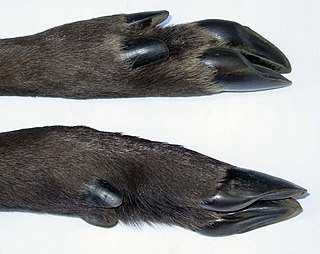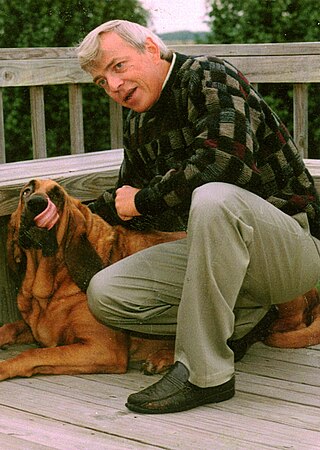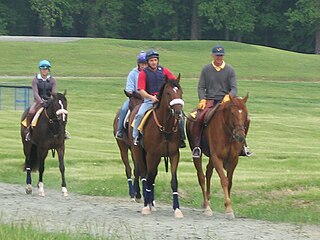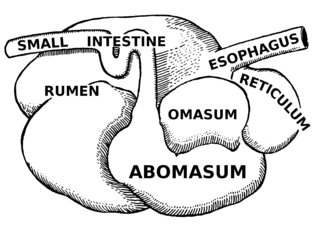
A veterinarian (vet) is a medical professional who practices veterinary medicine. They manage a wide range of health conditions and injuries in non-human animals. Along with this, veterinarians also play a role in animal reproduction, health management, conservation, husbandry and breeding and preventive medicine like nutrition, vaccination and parasitic control as well as biosecurity and zoonotic disease surveillance and prevention.

The hoof is the tip of a toe of an ungulate mammal, which is covered and strengthened with a thick and horny keratin covering. Artiodactyls are even-toed ungulates, species whose feet have an even number of digits; the ruminants with two digits are the most numerous, e.g. giraffe, deer, bison, cattle, goat, pigs, and sheep. The feet of perissodactyl mammals have an odd number of toes, e.g. the horse, the rhinoceros, and the tapir. Although hooves are limb structures primarily found in placental mammals, hadrosaurs such as Edmontosaurus possessed hoofed forelimbs. The marsupial Chaeropus also had hooves.

A dewclaw is a digit – vestigial in some animals – on the foot of many mammals, birds, and reptiles. It commonly grows higher on the leg than the rest of the foot, such that in digitigrade or unguligrade species, it does not make contact with the ground when the animal is standing. The name refers to the dewclaw's alleged tendency to brush dew away from grass. On dogs and cats, the dewclaws are on the inside of the front legs, similarly to a human's thumb, which shares evolutionary homology. Although many animals have dewclaws, other similar species do not, such as horses, giraffes and the African wild dog.

Onychectomy, popularly known as declawing, is an operation to remove an animal's claws surgically by means of the amputation of all or part of the distal phalanges, or end bones, of the animal's toes. Because the claw develops from germinal tissue within the third phalanx, amputation of the bone is necessary to fully remove the claw. The terms onychectomy and declawing imply mere claw removal, but a more appropriate description would be phalangectomy, excision of toe bone.

Laminitis is a inflammation of laminae that affects the feet of ungulates and is found mostly in horses and cattle. Clinical signs include foot tenderness progressing to inability to walk, increased digital pulses, and increased temperature in the hooves. There is also swelling in foot in some cases.Severe cases with outwardly visible clinical signs are known by the colloquial term founder, and progression of the disease will lead to perforation of the coffin bone through the sole of the hoof or being unable to stand up, requiring euthanasia.

Neuticles are prosthetic testicular implants for neutered dogs and other domestic animals. The implants may be made of polypropylene or silicone.

Kevin Terrel Fitzgerald, an American veterinarian who works at Alameda East Veterinary Hospital in his native Denver, Colorado is best known through his visibility on the Animal Planet reality show Emergency Vets and, more recently, E-Vet Interns. Fitzgerald also does stand-up comedy and a little tap dancing. In 2001, he was named one of the 50 most eligible bachelors by People.

Barbaro was a champion American Thoroughbred racehorse who won the 2006 Kentucky Derby but shattered his leg two weeks later in the Preakness Stakes which ended his racing career and eventually led to the decision to euthanize him.
Organ replacement in animals is an emerging field in veterinary science, focusing on improving and prolonging the lives of animals through the replacement or augmentation of damaged or dysfunctional organs. Despite its relative rarity compared to limb prosthesis, strides have been made over the decades, with notable milestones such as the first pacemaker surgery on a dog in 1968 and successful kidney transplants in cats since the mid-1980s. This field faces challenges, particularly in canine programs, due to issues related to immunosuppression. Ethical considerations also exist, particularly concerning the treatment of donor animals, underscoring the need for ongoing discussions and regulations in this dynamic field.

Veterinary surgery is surgery performed on non-human animals by veterinarians, whereby the procedures fall into three broad categories: orthopaedics, soft tissue surgery, and neurosurgery. Advanced surgical procedures such as joint replacement, fracture repair, stabilization of cranial cruciate ligament deficiency, oncologic (cancer) surgery, herniated disc treatment, complicated gastrointestinal or urogenital procedures, kidney transplant, skin grafts, complicated wound management, and minimally invasive procedures are performed by veterinary surgeons. Most general practice veterinarians perform routine surgeries such as neuters and minor mass excisions; some also perform additional procedures.

A trocar is a medical or veterinary device used in minimally invasive surgery. Trocars are typically made up of an awl, a cannula and often a seal. Some trocars also include a valve mechanism to allow for insufflation. Trocars are designed for placement through the chest and abdominal walls during thoracoscopic and laparoscopic surgery, and each trocar functions as a portal for the subsequent insertion of other endoscopic instruments such as grasper, scissors, stapler, electrocautery, suction tip, etc. — hence the more commonly used colloquial jargon "port". Trocars also allow passive evacuation of excess gas or fluid from organs within the body.
Veterinary anesthesia is a specialization in the veterinary medicine field dedicated to the proper administration of anesthetic agents to non-human animals to control their consciousness during procedures. A veterinarian or a Registered Veterinary Technician administers these drugs to minimize stress, destructive behavior, and the threat of injury to both the patient and the doctor. The duration of the anesthesia process goes from the time before an animal leaves for the visit to the time after the animal reaches home after the visit, meaning it includes care from both the owner and the veterinary staff. Generally, anesthesia is used for a wider range of circumstances in animals than in people not only due to their inability to cooperate with certain diagnostic or therapeutic procedures, but also due to their species, breed, size, and corresponding anatomy. Veterinary anesthesia includes anesthesia of the major species: dogs, cats, horses, cattle, sheep, goats, and pigs, as well as all other animals requiring veterinary care such as birds, pocket pets, and wildlife.

A cattle chute or cattle race also called a run or alley, is a narrow corridor built for cattle that separates them from the rest of the herd and allows handlers and veterinarians to provide medical care or restrain the animal for other procedures. A conventional cattle chute consists of parallel panels or fences with a space between them that is slightly wider than one animal so they are unable to turn around. Cattle chutes gently restrain the animal using a squeeze mechanism. The chute is connected to an alley, forming the animals into a queue that only allows them to go forward. Cattle tubs or a BudBox can also be used to help with animal flow and maintain low-stress cattle handling principles. It is used for routine husbandry activities such as drafting (sorting) or loading animals via ramp or loading chute into a vehicle; placing them one at a time in a cattle crush (variations also called a squeeze chute or standing stock) for examination, marking or veterinary treatment. They are also used at packing plants to move animals into a crush designed for slaughter.
Venomoid surgery is a surgical procedure performed on venomous snakes to prevent them from producing venom. The procedure has been used for snakes kept as pets or used in public demonstrations in order to remove the risk of injury or death when handled, but is considered illegal and unethical. Most venomoid procedures consist of either removing the venom gland itself, or severing the duct between the gland and the fang. Removal of fangs is uncommon, as snakes frequently regenerate teeth, and the more invasive procedure of removing the underlying maxillary bone would be fatal. However, the duct and gland have been known to regenerate, and supposedly "safe" snakes have killed mice and successfully envenomated humans.
Pet orthotics refers to the use of orthotics for pets. Orthotics is an allied health care field concerned with the design, development, fitting, and manufacture of orthoses. Orthoses, sometimes called braces or splints, are devices that support or correct musculoskeletal deformities and/or abnormalities of the body.

A cannulated cow or fistulated cow refers to a cow that has been surgically fitted with a cannula. A cannula acts as a porthole-like device that allows access to the rumen of a cow, to perform research and analysis of the digestive system and to allow veterinarians to transplant rumen contents from one cow to another.
Oscar is an all-black cat owned by Kate Allan and Mike Nolan who lives on the Channel Island of Jersey. In 2009 Oscar had both hind paws severed by a combine harvester. Since then he has undergone a pioneering operation to add prosthetic feet. The treatment has since been considered for use with humans. A book about Oscar's story, Oscar the Bionic Cat was published in 2013.

Morné de la Rey is a South African veterinary surgeon and embryo transfer specialist. In 2003, he was one of a team of scientists and veterinarians from his company Embryo Plus and the Danish Agriculture Institute to clone a cow, the first animal to be cloned in Africa. In 2016, he was one of a team to use in vitro fertilisation successfully for the first time in the Cape buffalo.

Displaced abomasum in cattle occurs when the abomasum, also known as the true stomach, which typically resides on the floor of the abdomen, fills with gas and rises to the top of the abdomen, where it is said to be ‘displaced’. When the abomasum moves from its normal position it prevents the natural passage of gas and feed through the digestive system, creating a restriction. As cattle are ruminants, which have a 4 chambered stomach composed of a rumen, reticulum, omasum and abomasum. Ruminants require this specialized digestive system in order to properly process and break down their high fiber and cellulose rich diets. As this type of digestive system is quite complex it is at a greater risk for incidence. Due to the natural anatomy of cattle it is more common to have the abomasum displace to the left, known as a left-displaced abomasum, than to the right, right-displaced abomasum. When the abomasum becomes displaced there also becomes a chance of an abomasal volvulus, twist, developing. An abomasal volvulus occurs when the abomasum, which is already out of place, will rotate and cut off blood and nutrient supply to the abomasum. Cattle which develop an abomasal twist require immediate vet attention to regain blood supply and food passage through the digestive system or the abomasum will begin to shut down due to lack of blood supply and toxicity development.

A veterinary prosthesis is a medical device that takes the place of an absent body part for an animal. These devices are created with the intention of mimicking the body part to serve the same purpose and functionality. The design of new animal prosthesis is driven by the needs of individual animals in consideration with environmental requirements and attachment sites.
















